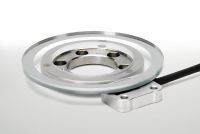Heidenhain Releases Compact Angle Encoder

Distinguishing itself by its flat design, no integral bearing and very small scanning head, Heidenhain's newest angle encoder is now being introduced to the marketplace. Called the ERO 6000, this new angle encoder is suitable for use in many metrology systems, in compact rotary tables and high dynamic applications such as air bearing spindles, laser trackers and robot arms. The compact scanning head of the ERO 6000 is made possible primarily by the application of a divergent scanning principle that does not require lenses or other beam-directing optics. The scale graduation is an extremely sturdy and high quality Metallur graduation and is adhered very accurately to a steel hub. This scanning method is new in Heidenhain angle encoders. The component's resulting grating period is 20 um, regardless of diameter.
Small scanning heads usually require small scanning fields, which are more sensitive to contamination due to the scanning principle. To counteract this characteristic, a signal error compensation function is integrated in the encoder's scanning sensor, which compensates the amplitude size and amplitude ratio within certain limits and thus increases the reliability and safety margin of the device.
Two ERO 6000 design types with line counts of 9,000 and 18,000, respectively, are being introduced currently. The encoders are available with 1 VPP and TTL interfaces. When it comes to mounting, the disk/hub assembly can be centered mechanically via 3-point centering or electrically with a second scanning head.





